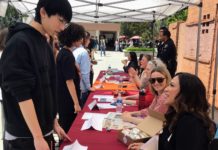Michael Cacciotti, who has served on the South Pasadena City Council since 2001, will go up against resident Eric Brady in a bid to retain his seat on the 5-member panel.
Cacciotti has pulled papers for the November 6 council election in the newly established district-based election. The current councilmember is expected to meet the August 10 deadline to turn in his necessary paperwork. He and Brady, who has already filed, will represent District 4.
At this time, little is known about Brady. A series of questions were emailed to the candidate seeking his response. (Look for a follow-up article once Brady replies to the questioning).

Incumbent Diana Mahmud, who has pulled papers and submitted them to county officials, will represent District 5. She has no opposition at this time.
In a district-based election system, a candidate must live in the district he or she wishes to represent.
In July 2017, the South Pasadena City Council initiated steps toward a district-based voting system to replace the current at-large voting system for City Council elections.
The council took action after receipt of a letter on June 5, 2017 containing allegations that the city’s at-large election system violates the California Voting Right’s Act (CVRC). Malibu-based attorney Kevin Shenkman, on behalf of his client, Southwest Voter Registration Education Project, wrote the letter.
The letter alleged there is evidence of Latino “polarized voting” in the City of South Pasadena electorate under the CVRA. Any evidence of the racially polarized voting is sufficient to require a court to order a change from at-large voting to district based voting. Racially polarized voting occurs when there is a difference between the choice of candidates preferred by voters in a protected class, and the choice of candidates preferred by voters in the rest of the electorate.
Approximately 20 percent of South Pasadena residents are Latino and unlike other cities where at-large elections have prevented Latinos from electing candidates of their choice, the electoral history for the City Council of the City of South Pasadena demonstrates that Latino candidates have been regularly elected in recent history. Since 2007, Latinos have won two of the three times they were on the ballot, serving a total of eight out of 10 years.
Today, the South Pasadena City Council is represented by residents from a diverse range of racial and ethnic backgrounds including Asian American, Latino, Armenian, Italian, and Caucasian.
One criticism expressed about forcing a district-based election system is that it can actually dilute the voting power of the very minority it seeks to empower, by limiting that group to the selection of one Councilmember within their district once every four years, rather than the opportunity to elect two or three Councilmembers every two years.
The City of South Pasadena contributed to this article.


















.png)











